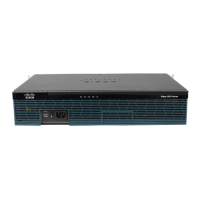C-16
Cisco 3900 Series, Cisco 2900 Series, and Cisco 1900 Series Integrated Services Routers Generation 2 Software Configuration Guide
Appendix C Using ROM Monitor
How to Use the ROM Monitor—Typical Tasks
Examples
In the following example, the percentage of DRAM used for I/O memory is set to 15:
rommon 2 > iomemset
usage: iomemset [smartinit | 5 | 10 | 15 | 20 | 25 | 30 | 40 | 50 ]
rommon 3 >
rommon 3 > iomemset 15
Invoking this command will change the io memory percent
*****WARNING:IOS may not keep this value*****
Do you wish to continue? y/n: [n]: y
rommon 4 > meminfo
-------------------------------------------------
Current Memory configuration is:
Onboard SDRAM: Size = 128 MB : Start Addr = 0x10000000
-----Bank 0 128 MB
-----Bank 1 0 MB
Dimm 0: Size = 256 MB : Start Addr = 0x00000000
-----Bank 0 128 MB
-----Bank 1 128 MB
-------------------------------------------------
Main memory size: 384 MB in 64 bit mode.
Available main memory starts at 0xa0015000, size 393132KB
IO (packet) memory size: 10 percent of main memory.
NVRAM size: 191KB
Recovering the System Image (tftpdnld)
This section describes how to download a Cisco IOS software image from a remote TFTP server to the
router flash memory by using the tftpdnld command in ROM monitor mode.
Caution Use the tftpdnld command only for disaster recovery because it can erase all existing data in flash
memory before it downloads a new software image to the router.
Before you can enter the tftpdnld command, you must set the ROM monitor environment variables.
Prerequisites
Connect the TFTP server to a fixed network port on your router.
Restrictions
• LAN ports on network modules or interface cards are not active in ROM monitor mode. Therefore,
only a fixed port on your router can be used for TFTP download. This can be a fixed Ethernet port
on the router, that is either of the two Gigabit Ethernet ports on Cisco routers with those ports.
• You can only download files to the router. You cannot use the tftpdnld command to retrieve files
from the router.

